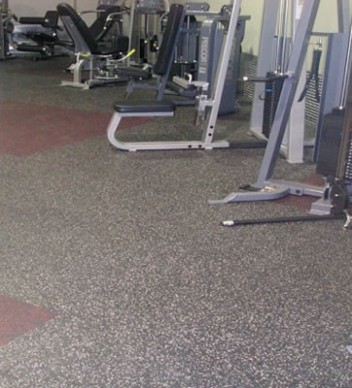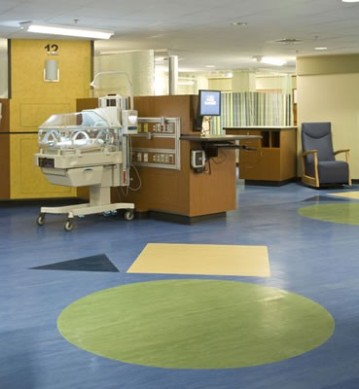Benefits of Rubber Flooring
Flexco Repel
Flexco Prime Sports
Flexco Distinct Designs & Creative Elements
Roppe Designers Choloee Rubber Tile
Rubber flooring is becoming more and more popular, both in homes and in commercial settings, and there is a good reason for it. More people are discovering the unique benefits that rubber flooring offers, and how they are especially valuable in a setting that is prone to spills, heavy usage and wear and tear. Rubber flooring is a very versatile floor covering option however; it is often over looked by floor covering professionals. There is a misconception surrounding rubber flooring that it is very expensive and hard to maintain. Although it is not the cheapest option, rubber flooring does provide very good long-term value. Following the manufacturers’ maintenance schedule will alleviate the myth about difficult cleaning. If you want a floor covering option that is unique, rubber flooring is worth a look.
The inherent properties of rubber flooring are durability, natural resiliency and low maintenance. Rubber flooring is also incredibly durable. These features have allowed rubber flooring to become an ideal choice for a great many applications. Health care, institution, offices and retail installations have become the home for rubber flooring applications. Some of the many other advantages are listed below;
Resilient floor for comfort
Rubber is a great surface for areas where people must stand for long periods of time.
Cushioning reduces fatigue and foot injury. In addition, it does not produce static
buildup, making it a great choice for restaurant kitchen and bar areas.
Dimensionally stable
PVC Free
Sound absorbent and Static Resistant
Excellent slip resistance
Some types of rubber flooring exceed the minimum standard set for allowed slippage, called the “coefficient of friction,” by 80 percent or more.
Water resistant
Resistance to heavy impact loads
Rubber floors are hard to gouge, scuff or scratch, giving them tremendous longevity.
Resistant to cigarette burns and chemical spills
Naturally resilient against staining, mildew and mold, so they look great for years.
Homogeneous construction
Color uniformity
No health or environmental concerns
Natural rubber is a rapidly renewable raw material extracted from the sap of the tropical rubber.
Made in the USA
Recyclable
The recycled rubber is chopped and cut into one of three primary products: landscaping mulch, playground surfacing or rubber crumb for athletic fields and other applications. The rubber can be treated with a new-age EPA approved adherent paint, if desired. The end product is a cost effective rubber mulch that simultaneously promotes the environment and provides a beautiful, durable landscaping alternative or an eye-catching playground surfacing that is the cleanest and safest on the American market.
Easy to maintain
Rubber flooring has been a floor covering of choice in commercial, educational, institutional, and government facilities where longevity, slip resistance, and resilience are important to occupant comfort and safety. Today, the number and variety of facilities featuring rubber floor coverings are growing since architects and designers are responding to the exciting new colors and patterns, and facility managers and building owners are exploring new opportunities to incorporate environmentally friendly products into their buildings. Rubber flooring has gained popularity because its attractive designs and patterns are compatible with today’s architectural trends without sacrificing performance, sustainability, or cost. More importantly, rubber flooring is durable, contributes to improved indoor air quality (IAQ), and is environmentally friendly. With many stylish colors and textures available to choose from, Rubber flooring has moved out of institutions and is starting to be used more and more in residential applications. Home bars, recreation rooms, laundry, mud rooms and home offices are just a few ideal locations for rubber floor covering.
The durability and long life-cycle of rubber floor coverings appeal to those who seek green building status, reducing the need for frequent removal and disposal, and conserving natural resources in the process in terms of both the flooring products themselves and the adhesives required to install them.
When it’s time to remove and discard rubber flooring, recycling is an option. Specialty firms recycle granulated rubber floor coverings for use as landing mats, industrial or stable mats, and coverings for sports arenas. Old rubber floor coverings can also be used in thermal recycling, serving as a substitute fuel for gas or oil in thermal stations where the energy contained in the combustible material is recovered. The disposal of cuttings and old floor coverings is an important part of energy recovery in the cement industry through thermal recycling.
When recycling is not an option, rubber flooring can be disposed of easily in landfills according to local, state, and federal regulations and policies. The absence of polyvinyl chlorides (PVCs) in some rubber-flooring products ensures that no harmful plasticizers, halogens, or dioxins will seep into the groundwater. The absence of PVCs provides other advantages as well, including the guarantee that no hydrochloric gas is produced in the event of fire and no corrosive hydrochloric acid results from contact with the water used to extinguish the fire. In addition, no toxic halogenated dioxins and furans are produced. Many of the environmental features that make rubber flooring an attractive choice also contribute to LEED points.
Considering the environmental benefits, along with rubber flooring’s durability, Indoor Air Quality friendliness, and other characteristics, rubber becomes an attractive floor covering solution.
For more information on our Rubber Flooring Suppliers, I have added the following links;
http://www.armstrong.com/commflooringna/stair-tread-accessories.html http://www.flexcofloors.com/index.asp
http://www.roppe.com/
Special thanks to JJ Haines for the information.




